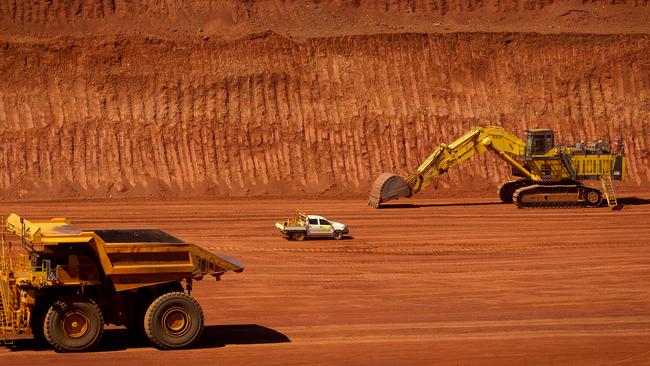Iron ore price to defy probe threat
The iron ore price is set to stay strong into the early part of next year, analysts say.

The iron ore price is set to stay strong into the early part of next year, analysts say, despite calls from China’s peak steel industry group for government intervention in the market over complaints of market manipulation.
Australian iron ore producers took a hit on the market on Tuesday after the China Iron and Steel Association said it had called on regulators at the State Administration of Market Supervision and the China Securities Regulatory Commission to investigate recent iron ore prices and “severely crack down on possible violations of laws and regulations”.
Both BHP and Rio Tinto have been called into meetings for a dressing down over high iron ore prices by CISA over the past two weeks, amid new threats by the peak body — part of a pattern of behaviour from CISA dating back more than a decade — to seek Chinese government assistance to moderate iron ore prices.
Iron ore marketing consultant Philip Kirchlechner, who helped establish Fortescue’s sales into China in the company’s early days and who still consults to many of Australia’s smaller producers, told The Australian the threat of intervention by Chinese regulators should always be taken seriously.
But he added the fundamentals of supply and demand would ultimately decide iron ore prices.
Mr Kirchlechner said there was little doubt high iron ore prices were putting Chinese steelmakers under pressure, but the price was being driven by demand.
“China is an active participant in the price-setting process, and the steel mills are a part of that. If they do anything to impede the free flow of iron ore the cost to China will increase,” he said.
Fortescue Metals Group shares closed down 3.1 per cent, or 68c, to $21.48 on Tuesday, with Rio Tinto down 1.3 per cent, or $1.52 to $112.42 and BHP off 96c, or 2.2 per cent, to $41.78, as CISA’s threats of regulatory intervention hit sentiment in the red-hot market for iron ore stocks.
And resources analysts said on Tuesday strong demand for steel in China would likely keep iron ore prices high for at least the first quarter of 2021, despite the pressure being put on margins at China’s steel mills by high input costs.
The cost increase is a result of the surging iron ore prices, but also China’s actions blocking the import of Australian metallurgical coal, which has dramatically pushed up domestic prices in China.
In a client note on Tuesday, JPMorgan analyst Lyndon Fagan said “materially higher near-term forecasts” for the iron ore price were justified on tightness in global supply, partly caused by lower expectations of a ramp-up in supply from Brazilian mines, and from the threat of cyclone disruption to Australian mines in the Pilbara.
JPMorgan lifted its average price expectations for 2021 by 20 per cent to $US126 a tonne, saying it expected the benchmark iron ore price to average about $US140 a tonne in the first quarter.
“The spot price at plus $US155 a tonne looks sentiment-driven, but we believe materially higher near-term forecasts are justified on market tightness,” he said.
“We believe market tightness will persist for several years. Over the long term, higher peak steel output in China requires more marginal supply. We have also raised our long term price from $US60/t to $US70/t.”
Morgan Stanley analysts said the current iron ore price, which tipped over $US160 a tonne late last week, was trading ahead of fundamentals, but said the rapid erosion of China’s port stockpiles of iron ore suggested elevated commodity prices were set to remain in place.
“The rate of erosion of China’s port stocks suggests the market is currently in an 80 million tonne a year deficit, with the price $US50/t above its ‘normal’ level’,” said a Morgan Stanley research note.
“Clearly the market is pricing in more tightness to come, with speculative inflows on the Dalian and Singapore exchanges driving the price higher; but we forecast a seaborne deficit of ‘just’ 35Mt next year.”
BHP confirmed on Monday it met with CISA officials last week, and Rio is expected to attend a similar meeting this week.
The meetings were called over this month’s iron ore spike that has sent prices above $US160 a tonne, and after the Pilbara Ports Authority last week released data showing exports through Port Hedland had softened 13 per cent in November.
China’s futures markets took action this week to try to cool speculative trading in iron ore, with the Dalian Commodity Exchange scrapping a 50 per cent transaction fee reduction for iron ore futures contracts, and the Zhengzhou Commodity Exchange increasing transaction fees on some thermal coal futures contracts.

